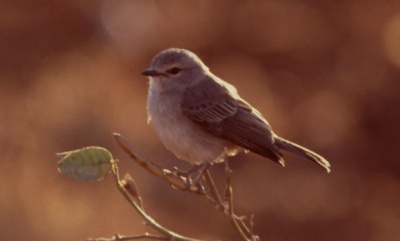Alternative names: Large Flycatcher; Large Grey Flycatcher; Grayish Flycatcher
- Bradornis microrhynchus
Includes: Little Grey Flycatcher or Ethiopian Flycatcher or Small Grey Flycatcher (See here for Muscicapa epulata, Little Grey Flycatcher)
Identification
14 cm (5½ in). A small drab, nondescript dumpy grey-brown flycatcher.
- overall grey brown: varies from very pale greyish to quite brown
- underparts slightly paler
- mantle, wings and tail slightly darker
- wings with pale feather fringes
- forehead and crown with diagnostic dark longitudinal streaks (generally impossible to see)
- legs dark
- eye dark
- bill dark
Distribution
Africa:
Western Africa: Liberia, Ivory Coast, Ghana, Cameroon, Central African Republic, Equatorial Guinea, Gabon, Congo
Eastern Africa: South Sudan, Ethiopia, Somalia, Kenya, Uganda, Tanzania, Zambia
Taxonomy
Like all members of the genus Bradornis this species is sometimes included in Melaenornis as Melaenornis microrhynchus [2].
Sometimes subspecies pumilus is split as "Little Grey Flycatcher", "Ethiopian Flycatcher" or "Small Grey Flycatcher", Bradornis pumilus.
Subspecies
Clements recognises the following subspecies [1]:
- B. m. neumanni: Southeastern South Sudan, southern Ethiopia, central and southern Somalia, northern Uganda, and northern Kenya
- B. m. pumilus: Central Ethiopia to northern Somalia
- B. m. burae: Eastern Kenya to south-eastern Somalia
- B. m. microrhynchus: South-western Kenya to western Tanzania and north-eastern Zambia
- B. m. taruensis: South-eastern Kenya
Habitat
Dry country, open thornbush and scrub, including acacia.
Behaviour
They are generally to be found in pairs or small family groups.
Diet
Their diet consists of caterpillars, insect larvae, moths, grasshoppers and beetles.
References
- Clements, J. F., T. S. Schulenberg, M. J. Iliff, D. Roberson, T. A. Fredericks, B. L. Sullivan, and C. L. Wood. 2017. The eBird/Clements checklist of birds of the world: v2017, with updates to August 2017. Downloaded from http://www.birds.cornell.edu/clementschecklist/download/
- Avibase
- Handbook of the Birds of the World Alive (retrieved Feb 2018)
Recommended Citation
- BirdForum Opus contributors. (2025) African Grey Flycatcher. In: BirdForum, the forum for wild birds and birding. Retrieved 9 May 2025 from https://www.birdforum.net/opus/African_Grey_Flycatcher




